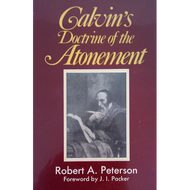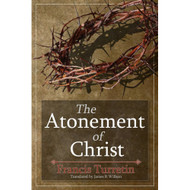Categories
Categories
Christ's Doctrine of the Atonement by George Smeaton (Hardcover)
Product Description
George Smeaton was one of the great luminaries in the theological galaxy which graced New College, Edinburgh, in the second half of the nineteenth century. His colleague James MacGregor said that he possessed ‘the best constituted theological intellect in Christendom’. His invaluable study of our Lord’s teaching on the significance of his death gives substance to that claim. In it we find Smeaton’s sensitive theological acumen, his skill in judicious exposition, and his evident devotion to the person of Jesus Christ – all combined in a masterly survey of the Gospel texts which illumine the doctrine of the atonement. Christ’s Doctrine of the Atonement, like its companion volume on the Apostles’ doctrine, is a work to be read and re-read. Those who possess it will often find themselves instinctively turning to consult Smeaton for insight on passages where other works have failed them.
Table of Contents
| CHAPTER I. | ||
| THE SOURCES OF OUR KNOWLEDGE IN THE RECORDED SAYINGS OF JESUS, AND THE MODE OF INVESTIGATION. | ||
| SECT. I. – The Four Gospels the sources of our knowledge as to the Sayings of Jesus, | 3 | |
| SECT. II. – The Number of our Lord’s Testimonies to the Atonement, and the Circumstances connected with them, | 9 | |
| SECT. III. – Whether all the Testimonies of Christ on His Atoning Death are recorded, | 13 | |
| SECT. IV. – The Method to be followed in evolving the Import of His Sayings, | 15 | |
| SECT. V. – The Importance of Biblical Ideas on Christ’s Death, | 17 | |
| 2 | CHAPTER II. | |
| THE POSTULATERS OR PRESUPPOSITIONS OF THE DOCTRINE OF ATONEMENT. | ||
| SECT. VI. – The Atonement a Divine Provision to put away Sin and all its consequences, | 20 | |
| SECT. VII. – Separate Sayings which affirm or imply the Necessity of the Atonement, | 22 | |
| SECT. VIII. – The Incarnation comes into the Remedial Economy as a Means to an End, | 39 | |
| SECT. IX. – Divine Love providing the Atonement; or the Love of God in Harmony with Justice as the only Channel of Life, | 44 | |
| SECT. X. – Single Phrases descriptive of the Unique Position of Jesus, or His Standing between God and Man, | 51 | |
| SECT. XI. – Sayings of Jesus referring to a sending by the Father, | 55 | |
| SECT. XII. – Sayings of Christ which assume that He is the Second Adam, and acting according to a Covenant with the Father in this Atoning work, | 63 | |
| SECT. XIII. – The Influence of Christ’s Deity in the matter of the Atonement, | 69 | |
| 3 | CHAPTER III. | |
| THE CONSTITUENT ELEMENTS OF THE ATONEMENT. | ||
| SECT. XIV. – Christ consciously fulfilling all that was written in the Law of Moses, the Prophets, and the Psalms concerning Himself, | 79 | |
| SECT. XV. – The First Classification of the Sayings into those which represent Christ as the Sin-Bearer, and then as the willing Servant, | 92 | |
| SECT. XVI. – The Baptist’s Testimony to Jesus as the Sin-bearer, | 94 | |
| SECT. XVII. – The frequently repeated name, the Son of Man, further exhibiting Him as the Sin-bearer, | 110 | |
| SECT. XVIII. – Christ receiving Baptism as the Conscious Sin-bearer, | 128 | |
| SECT. XIX. – Christ as the Sin-bearer taking on Him, during His earthly Life and History, the Burdens and Sicknesses of His People, | 135 | |
| SECT. XX. – The Historic Facts of Christ’s Sufferings illustrated by His Sayings, | 142 | |
| SECT. XXI. – The Sayings of Christ as the Conscious Sin-bearer in prospect of His Agony, and during it, | 145 | |
| SECT. XXII. – Single expressions used by Christ in reference to a Work given Him to do, | 160 | |
| SECT. XXIII. – Christ the Sin-bearer testifying that He was to be numbered with Transgressors during His Crucifixion, | 168 | |
| SECT. XXIV. – The Connection between the Lord’s Atonement and His Resurrection without seeing Corruption, | 182 | |
| 4 | CHAPTER IV. | |
| THE EFFECTS OF CHRIST’S DEATH. | ||
| SECT. XXV. – The Classification of Christ’s Sayings as they represent the Effects of His Death, and, in the first place, as they set forth His Death as the Ground of the Acceptance of our Persons, | 186 | |
| SECT. XXVI. – Christ describing Himself as Dying to be a Ransom for Many, | 190 | |
| SECT. XXVII. – The Testimony of Christ, that His Death is the Sacrifice of the New Covenant for the Remission of Sin, | 207 | |
| SECT. XXVIII. – Christ Fulfilling the Law for His People, and thus bringing in a Righteousness or Atonement for them, | 224 | |
| SECT. XXIX. – Sayings which represent the Death of Jesus as His Great Act of Obedience, and as the Righteousness of His People, | 241 | |
| SECT. XXX. – Christ Offering Himself, that His Followers might be Sanctified in Truth, | 245 | |
| SECT. XXXI. – Sayings relative to the subjective Lifegiving Effects of Christ’s Death, | 254 | |
| SECT. XXXII. – Christ Crucified the Antitype of the Brazen Serpent, and the Lifegiver, | 257 | |
| SECT. XXXIII. – Christ Giving His Flesh for the Life of the World, | 270 | |
| 5 | CHAPTER V. | |
| THE RELATION OF THE ATONEMENT TO OTHER INTERESTS IN THE UNIVERSE. | ||
| SECT. XXXIV. – Testimonies showing the Relation of the Atonement to other Interests in the Universe, | 283 | |
| SECT. XXXV. – The Death of Christ in connection with the Raising of the Temple of God, | 285 | |
| SECT. XXXVI. – The Atonement of Christ deciding the Judicial Process to whom the World shall belong, | 294 | |
| SECT. XXXVII. – Christ, by means of His Atonement, overcoming the World, | 300 | |
| SECT. XXXVIII. – The Atonement of Christ denuding Satan of his Dominion in the World, | 304 | |
| SECT. XXXIX. – Christ’s Vicarious Death taking the Sting out of Death, and abolishing it, | 313 | |
| SECT. XL. – Christ laying down His Life for the Sheep, and thus becoming the actual Shepherd of the Sheep, | 319 | |
| SECT. XLI. – Sayings which represent Christ’s Dominion, both General and Particular, as the Reward of His Atonement, | 334 | |
| SECT. XLII. – The Influence of the Atonement in procuring the Gift of the Holy Ghost, | 342 | |
| SECT. XLIII. – Christ’s Abasement as the Second Man opening Heaven, and restoring the Communion between Men and Angels, | 351 | |
| SECT. XLIV. – Sayings of Jesus which represent the Atonement as glorifying God, | 356 | |
| 6 | CHAPTER VI. | |
| THE ACTUAL EFFICACY OF THE ATONEMENT; OR THE QUESTION FOR WHOM IT WAS SPECIALLY OFFERED. | ||
| SECT. XLV. – The Efficacious Character of the Atonement; or the Special Reference of the Death of Christ to a People given Him, | 365 | |
| SECT. XLVI. – The Atonement extending to all Times in the World’s History, and to all Nations, | 380 | |
| 7 | CHAPTER VII. | |
| THE APPLICATION OF THE ATONEMENT. | ||
| SECT. XLVII. – Sayings which particularly relate to the Application of the Atonement, | 383 | |
| SECT. XLVIII. – The Preaching of Forgiveness based on the Atonement, and ever connected with the Atonement | 385 | |
| SECT. XLIX. – The Place which Christ assigns to the Atonement in the Christian Church, | 392 | |
| SECT. L. – Christ’s Sayings which represent Faith as the Organ or Instrument of receiving the Atonement, | 396 | |
| 8 | CHAPTER VIII. | |
| THE ENDLESS HAPPINESS OR WOE OF MANKIND DECIDED BY ITS RECEPTION OR REJECTION. | ||
| SECT. LI. – Endless Happiness or Irremediable Woe decided by the manner in which Men welcome or reject the Atonement, | 401 | |
| SECT. LII. – The Influence of the Atonement, correctly understood, on the whole Domain of Morals and Religion, | 407 | |
| Appendix of Notes and Historical Elucidations, | 415 | |
| INDICES. | ||
| I. Index to Texts, | 497 | |
| II. Index to Subjects, | 499 | |
| III. Index to the Authors adduced, | 500 | |
| IV. Index to Greek Words elucidated, | 502 |
About the Author
GEORGE SMEATON (1814–1889) was born in Berwickshire in the south of Scotland, and later studied at the University of Edinburgh. He became the minister of Falkland in 1839. At the Disruption in 1843, Smeaton demitted his charge in the Established Church and later that year became the minister of the Auchterarder congregation of the Free Church of Scotland.
In 1853, he took up the Chair of Divinity at the Free Church College in Aberdeen, and in 1857, was transferred to the New College in Edinburgh, where he held the position of Professor of New Testament Exegesis until his death.
Smeaton was held in high regard by his contemporaries—his colleague James
Macgregor thought that Smeaton had the best-constituted theological intellect in Christendom, and Dr Alexander Stewart of Edinburgh said that he was ‘perhaps the most learned theologian in the Free Church and a man of deep and unaffected godliness.’
Smeaton is best known for Christ’s Doctrine of the Atonement and The Apostle’s
Doctrine of the Atonement published in 1868 and 1870 respectively, and his Cunningham Lectures which were published as The Doctrine of the Holy Spirit in 1882, a work which B. B. Warfield considered to be one of the best books on the subject ever published.
Smeaton married Janet Goold in 1840 and had five children, four of whom died before him. The comfort he received from God in the midst of these bereavements enabled him in turn to be a great comforter to those in tribulation. As his obituary noted, ‘In the chamber of sickness and the house of mourning he was ever a welcome visitor, and to the last he did not grudge hours spent every week in this gentle and useful ministry.’
Endorsement
"George Smeaton’s magnificent studies of the New Testament’s teaching on the work of Christ-Christ’s Doctrine of the Atonementand The Apostles’ Doctrine of the Atonement [are] two books which I am convinced ought to be in the possession of every minister of the gospel, preacher, teacher and student for the ministry.
These books are reliable, but they are also wonderfully readable. Ministers at every age and stage will benefit from them, and be led by them through careful, biblical, spiritual exposition of the cross. They combine biblical exegesis, doctrinal exposition, spiritual meditation, depth without dense style, clarity without technical clutter."
 Loading... Please wait...
Loading... Please wait... 









